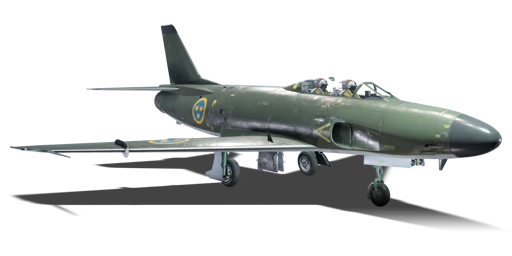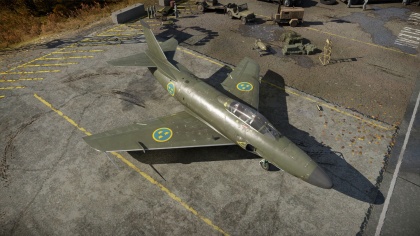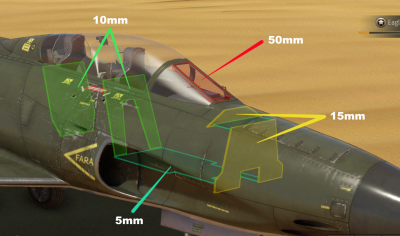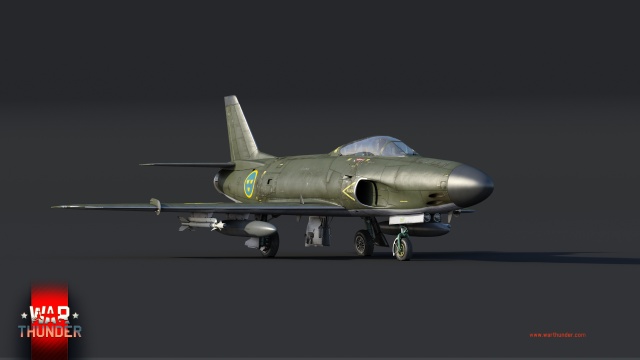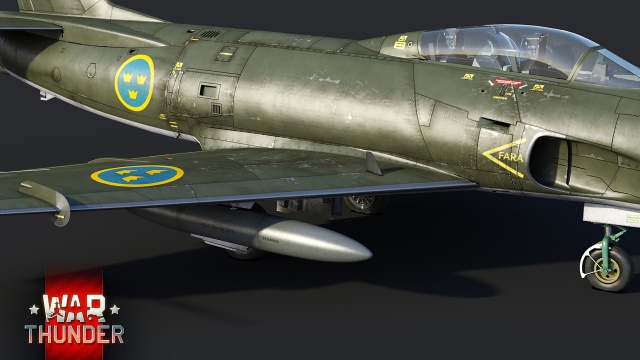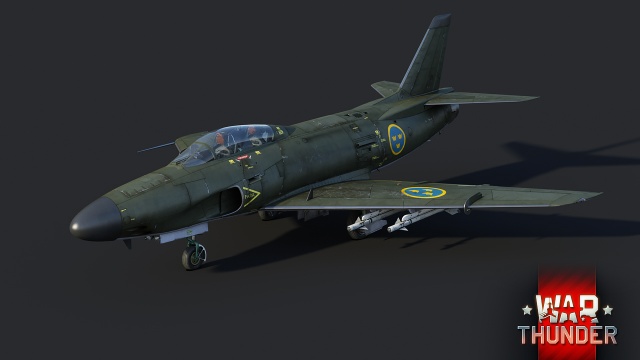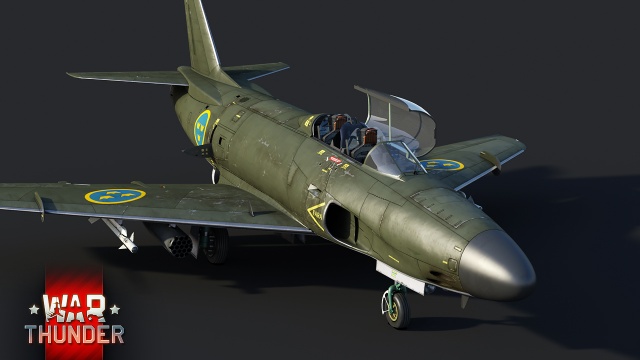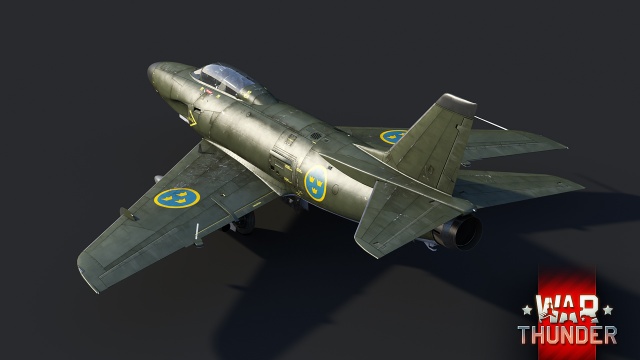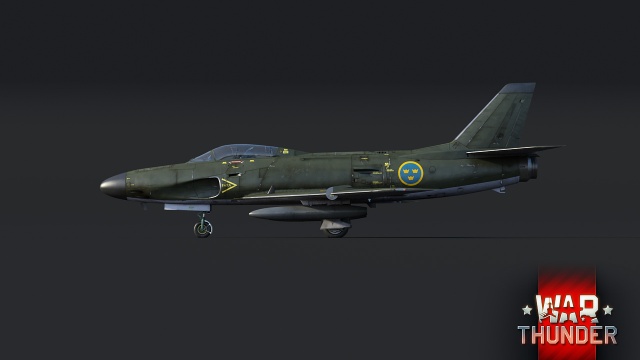Difference between revisions of "J32B"
(Edits) |
Inceptor57 (talk | contribs) m (→Pros and cons) |
||
| Line 191: | Line 191: | ||
* Excellent top speed - outruns most opponents | * Excellent top speed - outruns most opponents | ||
* 4 x 30 mm Akan m/55 - incredible burst mass and damage | * 4 x 30 mm Akan m/55 - incredible burst mass and damage | ||
| − | * 4 x RB24 air-to-air missiles - highly potent | + | * 4 x RB24 air-to-air missiles - highly potent missiles against adversaries |
* Powerful afterburning engine - excellent acceleration & energy retention | * Powerful afterburning engine - excellent acceleration & energy retention | ||
* Integrated radar | * Integrated radar | ||
Revision as of 16:31, 30 July 2020
Contents
| This page is about the Swedish jet fighter J32B. For the attack-oriented version, see A32A. |
Description
The J32B Lansen is a rank VI Swedish jet fighter
with a battle rating of 9.7 (AB/SB) and 9.3 (RB). It was introduced in Update 1.95 "Northern Wind".
The J32B is a Swedish subsonic interceptor, combining excellent climb-rate and devastating firepower, both in terms of suspended and offensive armaments.
General info
Flight performance
The Saab J32B Lansen is a powerful interceptor built for all-weather operations. Being the descendant of the earlier A32A, this version focuses on air-to-air combat instead of its previous role as an air-to-ground platform. To achieve this, the J32B received the new RM6A engine. This engine is a Swedish license-produced variant of the Avon 300, producing a staggering 6,810 kgf when engaged with full afterburner. This engine was originally developed for the Lightning F.6. This makes the J32B a subsonic plane with a supersonic engine, resulting in incredible acceleration and energy retention. Staying fast and avoiding dogfights is the main advantage of the J32B, as the airframe is relatively large and cumbersome, not really meant for aerial manoeuvres. However, a single pass is more than enough thanks to four centre-mounted Akan m/55 cannons, with a incredible 24 kg burst mass. The J32B is also outfitted with four RB24 air-to-air missiles capable of killing enemies far beyond the plane's reach. This, combined with the incredible thrust, lets the J32B decide when, and how to strike down opponents; a luxury most planes can only dream of.
| Characteristics | Max Speed (km/h at 0 m - sea level) |
Max altitude (metres) |
Turn time (seconds) |
Rate of climb (metres/second) |
Take-off run (metres) | |||
|---|---|---|---|---|---|---|---|---|
| AB | RB | AB | RB | AB | RB | |||
| Stock | 1,133 | 1,128 | 12500 | 34.4 | 34.6 | 84.5 | 78.5 | 900 |
| Upgraded | 1,148 | 1,140 | 33.6 | 34.0 | 119.5 | 101.0 | ||
Details
| Features | |||||
|---|---|---|---|---|---|
| Combat flaps | Take-off flaps | Landing flaps | Air brakes | Arrestor gear | Drogue chute |
| ✓ | ✓ | ✓ | ✓ | X | X |
| Limits | ||||||
|---|---|---|---|---|---|---|
| Wings (km/h) | Gear (km/h) | Flaps (km/h) | Max Static G | |||
| Combat | Take-off | Landing | + | - | ||
| 1160 | 450 | 550 | 550 | 320 | ~10 | ~4 |
| Optimal velocities (km/h) | |||
|---|---|---|---|
| Ailerons | Rudder | Elevators | Radiator |
| < 850 | < 650 | < 600 | N/A |
Engine performance
| Engine | Aircraft mass | |||||
|---|---|---|---|---|---|---|
| Engine name | Number | Empty mass | Wing loading (full fuel) | |||
| Svenska Flygmotor RM6A | 1 | 8,680 kg | 307 kg/m2 | |||
| Engine characteristics | Mass with fuel (no weapons load) | Max Takeoff Weight | ||||
| Weight (each) | Type | 8m fuel | 20m fuel | 28m fuel | ||
| 1,400 kg | Afterburning axial-flow turbojet | 9,491 kg | 10,675 kg | 11,464 kg | 13,500 kg | |
| Maximum engine thrust @ 0 m (RB / SB) | Thrust to weight ratio @ 0 m (WEP) | |||||
| Condition | 100% | WEP | 8m fuel | 20m fuel | 28m fuel | MTOW |
| Stationary | 4,727 kgf | 6,807 kgf | 0.72 | 0.64 | 0.59 | 0.50 |
| Optimal | 4,727 kgf (0 km/h) |
7,199 kgf (1,000 km/h) |
0.76 | 0.67 | 0.63 | 0.53 |
Survivability and armour
- 5 mm steel plate - cockpit floor and spacer plate between frontal armour.
- 10 mm steel plate - behind the pilot and GIB's seats
- 15 mm steel plate - armour plates in front of the cockpit section
- 50 mm bulletproof glass - armoured canopy windscreen
The J32B features good pilot protection. A 50 mm bulletproof screen, and plates surrounding the two pilots, reaching thickness levels of between 5 to 15 mm. These plates were originally meant to save the pilot from incoming ground-fire due to its earlier ground-attack purpose. Thanks to this excellent protection, as well as having two pilots instead of one, dying by a pilot knockout is highly unlikely in comparison to other fighters of the same rank. The J32B is also survivable in terms of fuselage strength. A single pass rarely knocks it out immediately, and seems more on-par with the Vautour IIA than other fighters at its rank. This strength can be attributed to the separated fuel-tanks, as well as the short engine (in relation to the fuselage). This high survivability makes the J32B quite forgiving for making mistakes, as it usually isn't hard to return back to base for repairs. It is important, however, to avoid all damage possible, as even the slightest fuselage damage can heavily cripple the J32B's general flight performance. A badly damaged fuselage makes the J32B unable to retain energy, keeping it away from its main advantage. The J32B is also prone to catching fire. Although the fire is easily put out, the damage suffered is usually more than fatal.
Armaments
Offensive armament
The J32B is armed with:
- 4 x 30 mm Akan m/55 cannons, nose-mounted (90 rpg = 360 total)
Suspended armament
The J32B can be outfitted with the following ordnance:
- Without load
- 38 x srak m/57B rockets
- 4 x RB24 missiles
- 2 x RB24 missiles + 38 x srak m/57B rockets
Usage in battles
This aircraft excels at being fast, it is important to use that advantage to quickly Boom & Zoom any unsuspecting enemies. Avoid utilising turning manoeuvres with other aircraft as every aircraft with the exception of the F-100D will shake you rather easily and you risk being pulled into a "reversal". Although you can easily out-run most jets, some aircraft like the Etendard IVM, MiG-17AS and Shenyang F-5 will easily catch up. These aircraft prove deadly to the J32B as they will keep up with your turns if you try to evade them, not to mention they also carry air-to-air missiles which they will certainly use to force you to bleed speed (if you don't get destroyed in the process). Your safest bet is to go in a straight line hugging the maximum safe speed (concern for realistic and simulator battles) and hope they pull away.
Modules
| Tier | Flight performance | Survivability | Weaponry | ||
|---|---|---|---|---|---|
| I | Fuselage repair | Offensive 30 mm | |||
| II | Compressor | Airframe | m/57 | ||
| III | Wings repair | Engine | New 30 mm cannons | ||
| IV | G-suit | Cover | RB24 | ||
Pros and cons
Pros:
- Excellent top speed - outruns most opponents
- 4 x 30 mm Akan m/55 - incredible burst mass and damage
- 4 x RB24 air-to-air missiles - highly potent missiles against adversaries
- Powerful afterburning engine - excellent acceleration & energy retention
- Integrated radar
- Above-average roll-rate
- Resistant to high-G manoeuvres (up to 10Gs)
- Decent pilot protection & airframe endurance
- Fowler flap design - provides excellent lift at low speeds
Cons:
- Mediocre manoeuvrability, almost every opponent it faces can out-manoeuvre it
- Difficult to land - landing flaps rip at 300 km/h
- Very inefficient air-brake design - requires high angle-of-attack or aggressive banking to slow down
- Large target - Easy to hit
- High rate of fire - ammunition will deplete very quickly, trigger control required
History
In the year 1948, SAAB started to develop a new type of multi purpose aircraft with capabilities such as a strike-fighter, interceptor or reconnaissance aircraft. The project was called P1150 and had the intent to replace the B18, J21A, A21R and the J30 aircraft. After some testing, a swept wing design typical for the time period was decided upon. After some testing with a Swedish jet engine design called the Dovern, it was decided that the engine lacked the desired power so a swap to the British Rolls-Royce Avon Mk.21 engine was decided upon due to its ability to produce more power without its afterburner on than the Dovern could even with the afterburner engaged. The airplane was designated the Saab 32 Lansen and flew for the first time in November 1952 with Bengt Olow as pilot.
A total of 447 aircraft were delivered to the Swedish Air Force from 1955 until 1960. These were modified and renovated until its retirement in 1997. A total of 10 variants were in service, including the prototype P1150.
Media
- Images
- Videos
See also
Links to the articles on the War Thunder Wiki that you think will be useful for the reader, for example:
- reference to the series of the aircraft;
- links to approximate analogues of other nations and research trees.
External links
| Swedish Aeroplane Company Ltd. (SAAB) | |
|---|---|
| Pre-SAAB: ASJA | J6B |
| Fighters | J21A-1 · J21A-2 · A21A-3 |
| Jet fighters | A21RB · J21RA · J29A · A29B · J29D · J29F · J32B · J35A · J35D · JA37C · JA37D · JAS39A |
| Jet attackers | A32A · A32A Röd Adam · AJ37 · AJS37 · SAAB-105G · SK60B |
| Bombers | B17A · B17B · S17BS |
| Dive-bombers | B3C · B18A · B18B · T18B · T18B (57) |
| Export | SAAB-105OE · Saab J35XS · JAS39C · ◔JAS39EBS HU C |
| Sweden jet aircraft | |
|---|---|
| Fighters | J21RA |
| J29A · A29B · J29D · J29F | |
| J32B | |
| J34 | |
| J35A · J35D | |
| JA37C · JA37D | |
| JAS39A | |
| Strike aircraft | A21RB |
| A32A · A32A Röd Adam | |
| A28B | |
| AJ37 · AJS37 | |
| SK60B · SAAB-105G | |
| Export | SAAB-105OE |
| Finland | ▄Vampire FB 52A · ▄MiG-21bis · Saab J35XS |


